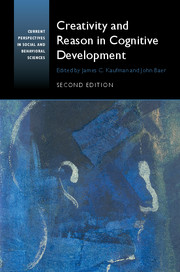Book contents
- Frontmatter
- Dedication
- Contents
- List of Contributors
- Acknowledgments
- 1 Creativity, Reason and Cognitive Development: Ten Years Later
- SECTION ONE CREATIVITY AND REASON IN CHILDHOOD AND THE SCHOOLS
- 2 Creativity in Young Children's Thought
- 3 Early Experiences and Creativity: An Ecological Perspective
- 4 Imaginative Play
- 5 Revisiting the Relationship among Schooling, Learning, and Creativity
- 6 Higher Level Thinking in Gifted Education
- 7 A Young Artist's Story: Advancing Knowledge and the Development of Artistic Talent and Creativity in Children
- SECTION TWO CREATIVITY AND REASON IN COGNITION AND NEUROSCIENCE
- SECTION THREE CREATIVITY AND REASON: INTERACTIONS AND RELATED CONSTRUCTS
- Author Index
- Subject Index
- References
4 - Imaginative Play
from SECTION ONE - CREATIVITY AND REASON IN CHILDHOOD AND THE SCHOOLS
Published online by Cambridge University Press: 05 February 2016
- Frontmatter
- Dedication
- Contents
- List of Contributors
- Acknowledgments
- 1 Creativity, Reason and Cognitive Development: Ten Years Later
- SECTION ONE CREATIVITY AND REASON IN CHILDHOOD AND THE SCHOOLS
- 2 Creativity in Young Children's Thought
- 3 Early Experiences and Creativity: An Ecological Perspective
- 4 Imaginative Play
- 5 Revisiting the Relationship among Schooling, Learning, and Creativity
- 6 Higher Level Thinking in Gifted Education
- 7 A Young Artist's Story: Advancing Knowledge and the Development of Artistic Talent and Creativity in Children
- SECTION TWO CREATIVITY AND REASON IN COGNITION AND NEUROSCIENCE
- SECTION THREE CREATIVITY AND REASON: INTERACTIONS AND RELATED CONSTRUCTS
- Author Index
- Subject Index
- References
Summary
Pretend play is a perfect vehicle for developing imagination in children. Pretend play involves self-generated manipulation of components of imagination. When playing, children manipulate mental representations, imagery, and memories and act them out. Many of these mental components are associated with emotion. Emotion-laden cognition, fantasies, and scripts are played out in a pretend world. The child creates new scripts, fuses images and memories, and generates new ideas. All of these mental events are important in creativity. Theoretically, these manipulations of components of imagination within pretend play should set the stage for creative thought. Pretend play helps children develop creative capacities. This chapter reviews theoretical approaches to imaginative play and creativity, research evidence, and neurological findings and theory that have implications for the development of imagination in play.
Pretend Play, Imagination, and Creativity
Pretend play is a symbolic behavior in which “one thing is playfully treated ‘as if’ it were something else” (Fein, 1987, p. 282). Fein (1987) also stressed the importance of affect expression in pretend play – cognitive and affective processes are intertwined in pretend play expressions. Singer and Singer (2013) have long proposed that pretend play serves as a “critical precursor” (p. 11) for the development of forming experiences into narratives, for guiding thought processes, and for noticing the content of one's stream of consciousness. Because so many of the cognitive and affective processes in pretend play are also involved in creative expression, pretend play is thought to be a precursor of creativity (Fein, 1987; Singer & Singer, 1990; Russ, 1993, 2014).
Russ (1993; 2014), based on both clinical and research literatures, articulated cognitive and affective processes that occur in imaginative pretend play. Cognitive processes involved in play include organization of narratives, symbolism, divergent thinking, fantasy/make-believe, and recombining and manipulating images and story events. A child demonstrates organization and imagination when he or she is able to tell a coherent story with fantasy sequences. Divergent thinking is a child's ability to create a multitude of different ideas that are not confined to conventional ways of thinking or problem solving and to use objects to represent different things, such as when a stick is used as a birthday candle. Fantasy/make-believe refers to a child's ability to pretend that he or she is in a different place or time and role play with various objects and other people.
- Type
- Chapter
- Information
- Creativity and Reason in Cognitive Development , pp. 52 - 71Publisher: Cambridge University PressPrint publication year: 2016
References
- 5
- Cited by

